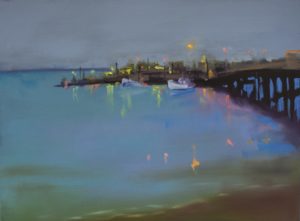Christine Niles’s narrative challenges the myth, mostly believed by nonartists, that artists are born and not made. “I always enjoyed the arts, but I didn’t feel myself drawn to them at a young age,” says the Provincetown painter. She credits her life as an artist to a combination of nature and nurture.
Niles grew up in Lexington, a leafy bedroom community west of Boston. A broad introduction to both fine arts and crafts along with a progressive education served young Niles well. “In the ’70s, we had kits: paint by numbers, build this, create this,” she recalls. “I had art in school; it was part of our education. It was just part of life to make things.”

Instead of attending the town’s highly regarded public schools, Niles studied at private schools — Belmont Day School, Buckingham Browne & Nichols, and the High Mowing School, a Waldorf school in New Hampshire. “I felt very disconnected from Lexington,” she says. “Lexington was where our house was, but I didn’t spend a lot of time there.”
After a year at a liberal arts college feeling no sense of direction, she transferred to the Swain School of Design in New Bedford, now part of UMass Dartmouth. “My boyfriend at the time went there and said, ‘This is a really cool place. Why don’t you come here?’ ” Niles says. “I know a lot of people spent their high school years building portfolios geared to art school and I just happened into it, but I think it worked to my advantage. I was totally open-minded, admitting I didn’t know what I was doing. There were definitely people who entered art school with an idea of being an artist and this is how to do it, and they were less open to learning something new.”
Her first experience with oil painting was “messy and difficult,” she says, “but thinking back on it, my paintings were OK. I persevered.” At Swain, Niles became fascinated by color theory, which also excited her when she first visited Provincetown 15 years ago. She witnessed firsthand the celebrated “Cape light” and its effect on landscape painting. She was especially moved by the sight of the “warm sun on the cool water.”

Niles had never been to Provincetown before she and her husband, Charles Nichols, started dating. “I was blown away,” she says. “It was seeing all the galleries and painting that made me go home and take out my paints again.” They began planning Cape vacations around workshops Niles wanted to take.
Niles and Nichols, who serves as deacon at St. Mary of the Harbor Episcopal Church, moved to Provincetown three years ago. Niles had been working in a hospital, and even before the Covid pandemic saw, through her patients, how quickly a person’s life can change. Upon moving to Provincetown, she immersed herself in her painting.
The walls of the couple’s East End house are covered, salon-style, with paintings by Cape artists — Charles Hawthorne, Hilda Neily, Chet Jones. As a visitor climbs the stairs up to Niles’s third-floor studio, Nichols pokes his head out from his study to say hello and joke that one requirement for their house was plenty of wall space to accommodate their art collection.
The studio is orderly. Two easels and a work table hog the light overflowing from the north-facing window. Finished work covers the walls and works in progress sit in neat piles. Charles Hawthorne and Impressionist Light, a two-day workshop Niles will be teaching at the Provincetown Art Association and Museum in June, is on her mind.

Niles’s works are small — no larger than 18 by 24 inches. There are a couple of reasons for this: for many years, she didn’t have a studio, and she also works in plein air as much as she can. “I have a real appreciation for small compositions, and I don’t necessarily think bigger is better,” she says. “There’s something about the preciousness of a small painting, and if you made it larger it just wouldn’t work.”
Niles is represented by kmoe gallery in Provincetown. She tries to price her work so that the average person coming over on the ferry can afford it. “I remember when I first started collecting art, and not just posters,” she says. “It’s really expensive, but it’s really special.
“I don’t feel in competition with the other artists; it’s more of a conversation,” Niles continues. “The opportunities that have happened for me here, I didn’t seek them out — they just have fallen in my lap. Someone will say, ‘My friend’s a gallerist, why don’t you show your work?’ or ‘They need teachers at PAAM, why don’t you apply?’ I don’t think that would have happened anywhere else but here.”
